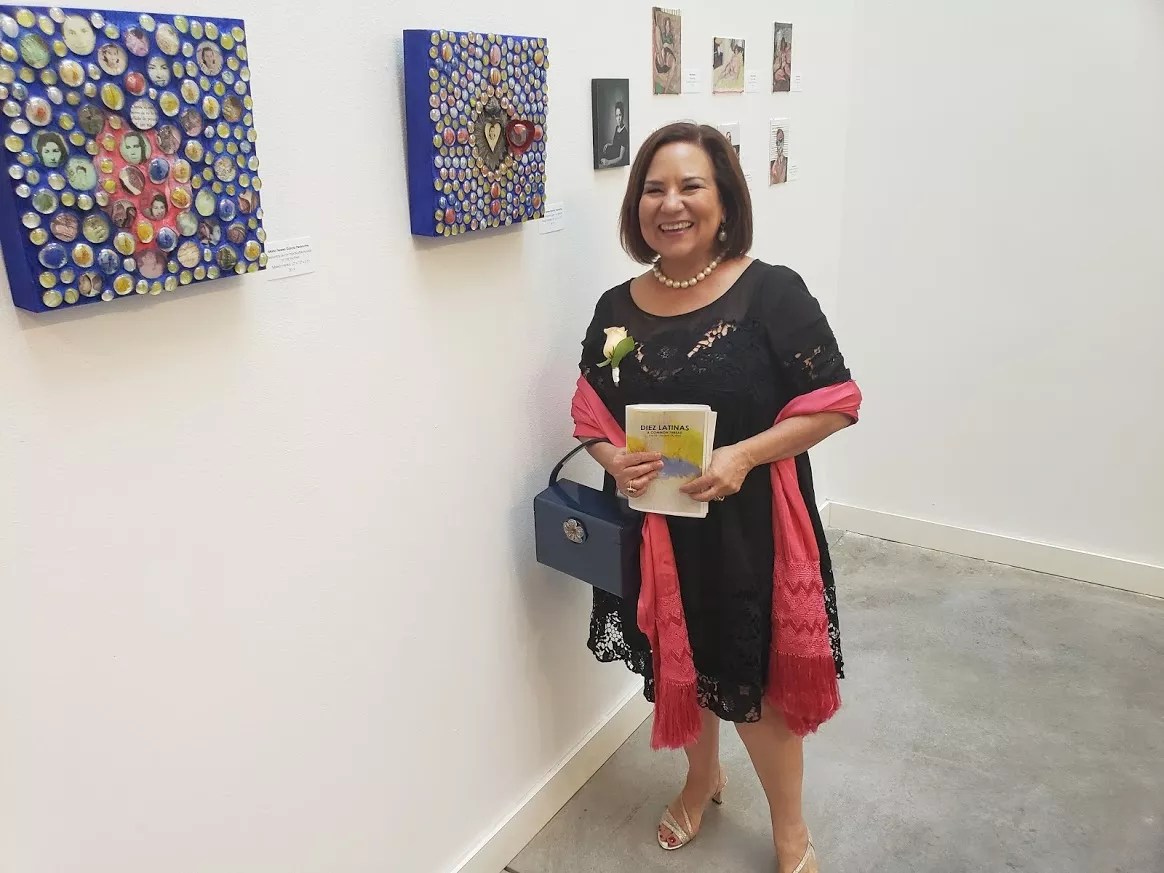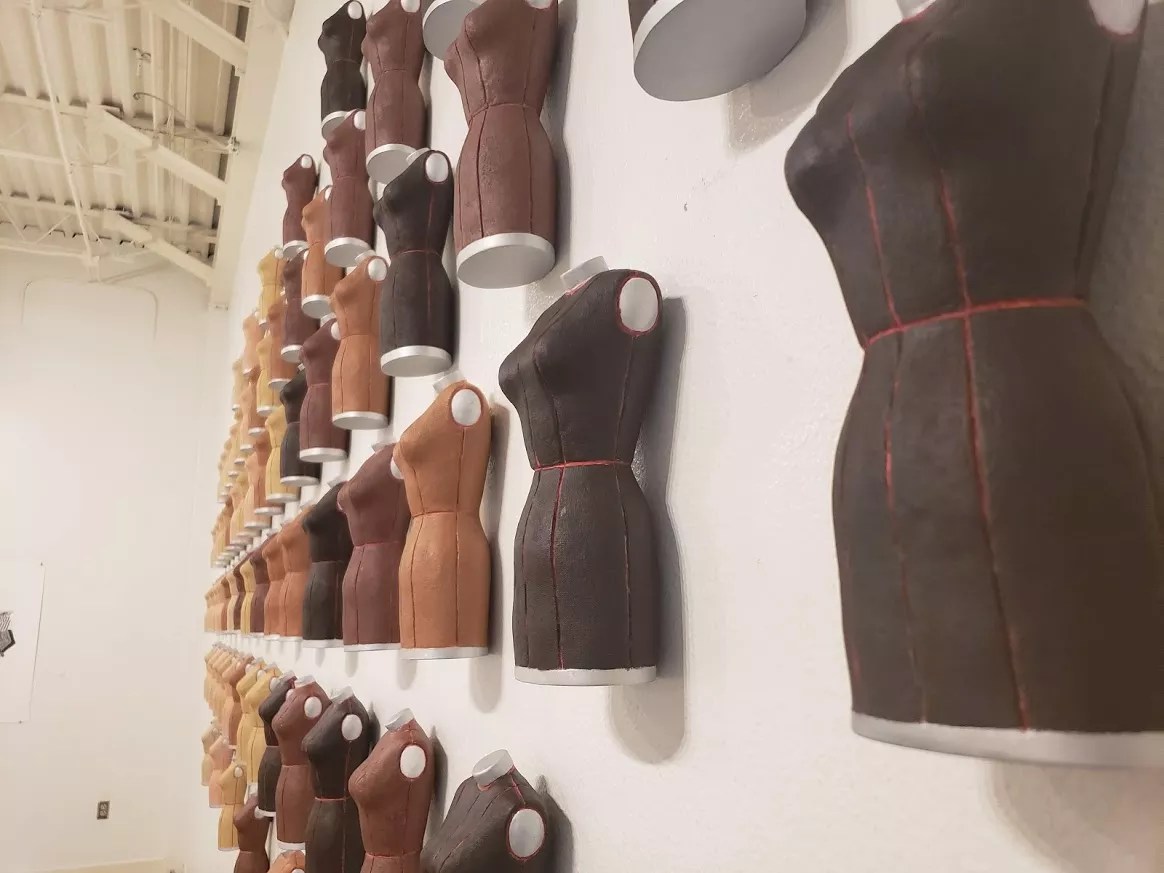
Ana Astri-O’Reilly

Audio By Carbonatix
“Gracias por venir, m’hija.” “Thank you for coming.” Artist and curator Viola Delgado greeted every person who came to the Diez Latinas show. The atmosphere at the Latino Cultural Center on Friday night was that of joy, a celebration of all things Latina. People of all ages and backgrounds, as well as families with young children -Viola’s special wish – came out to see the exhibition.
Viola Delgado is a native Texan artist, painter, sculptor and curator who has provided curatorial work for the Bath House Cultural Center, the Art Center of Plano, Mundo Latino at The Women’s Museum and the Latino Cultural Center.
Curating an art show that showcased Latina artists has been on Delgado’s mind for a long time. Years ago, when organizing a couple of shows at the Bath House Cultural Center together with artist Leticia Huerta, they realized that very few Latina artists had the chance to exhibit their work. In fact, few women artists in general are recognized and represented in U.S. museums. A study published in 2018 by the journal PLOS One analyzed the data of 18 art museums across the country. It found that only 12.6% of the artists represented were women, of which an insignificant 2.8% were Latinas.
In 2016, with the help of Benjamin Espino from the Latino Cultural Center, Delgado and Huerta put together a show called Cinco Latinas.
Will you step up to support Dallas Observer this year?
We’re aiming to raise $30,000 by December 31, so we can continue covering what matters most to you. If the Dallas Observer matters to you, please take action and contribute today, so when news happens, our reporters can be there.
“I think that it’s very important that people know that we’re here,” Delgado says.
Yvonne Acero, one of the five exhibiting artists, says that female Latin American artists “have to work almost double to get where we want to be.”
“The show made me feel validated and what I’d gone through was important, that I was on the right track,” says artist Sara Cardona. “As an artist, it helped me get exposure again.”
“The show made me feel validated and what I’d gone through was important, that I was on the right track.” — Sara Cardona
Diez Latinas builds upon Cinco Latinas. The themes of exposure, inclusion, migration, identity, gender, and memory are built upon in the Diez Latinas 2019: One Common Thread exhibition, which will run until Aug. 24 at the Latino Cultural Center. There will be a panel discussion on Saturday, Aug. 10, at 2 p.m. moderated by local journalist Dianne Solis.
Delgado says that Diez Latinas is about “the role of Latina women in the world.” Through her role as curator, she says she encourages artists to “continue doing their artwork and using their artwork as their voice.” There’s a nurturing and inspirational component to the exhibition. Delgado’s wish is that families bring their children and that they take away the message that hard work will pay off, and that it’s possible to break down barriers, just as these artists are paving the way in Dallas.
Acero left her native Colombia over 30 years ago. At the time of the Cinco Latinas exhibition, she was going through cancer treatment. As Acero had limited mobility, she started working on smaller “intimate pieces” and doing mixed media, working with fabric and doing embroidery. Working with her hands and staying active helped her recovery, Acero says. Now as then, her themes focus on memory, identity and gender.
“You’re a mix of different experiences; in my art I speak in a woman’s voice,” Acero says. The artist’s current series is about women of all races, highlighting what brings them together, rather than their differences.
Cardona was born in Mexico City but came to Texas with her parents, although she moved back and forth between the two countries as a child. That movement informed her present series, which uses blankets as a metaphor. The current issues at the southern border got Cardona thinking about her own journey.
“To me, a blanket is like when you reduce a house to a few things that you can take, it has a long history of being a transport system,” she says.
An abstract artist, Cardona found in collage a technique that she says suits her artistic needs. She sees herself as a film editor looking for images that interest her instinctively. Her pieces for this show are radial and represent “the circularity between the U.S. and Mexico.”
Mexican blankets, especially the Saltillo ones, have become a popular, albeit kitsch, item that Americans buy as a souvenir, Cardona says. She equates the blankets with movement across the border; the constant traffic of Mexicans and Americans in both directions.
Abstract sculptor Adriana Cobo was once told by a teacher that she would never be an artist because her drawings weren’t perfect. Cobo went on to get a degree in chemistry and pharmacy in her native Chile before she moved to the U.S. with her husband and children and started taking every art class she could and working with primitive clay.
Someone once suggested she should work with marble, so Cobo went to Pietrasanta, Italy, every summer for 20 years to learn to use the material. The artist uses different approaches to her work; she either has an idea for a piece and finds a suitable stone, or lets the stone dictate the piece. In this case, Cobo made a plaster figure first to use as a guide.
Cobo says she loses track of herself while working.
“Now, thanks to that teacher who told me no, I can say I’m a scientist and an artist,” she says.

Ana Astri-O’Reilly
Big Springs, Texas, native Diana Marquis was also told she’d never be an artist. In her case, teachers said she started “too late.” She was the oldest and least experienced student in her class. Marquis persevered and got a degree in fine arts and a master’s degree in humanities from Southern Methodist University.
Being told she wasn’t good enough gave her the freedom to experiment with clay and other materials. Marquis believes that there are many feminine archetypes involved in ceramics.
“The making of the vessel, the bowl, the cup – those are archetypes of femininity,” she says. “The cup is the breast that carries nourishment; the bowl also carries nourishment.”
Growing up in Ledbetter, West Dallas, has informed Angela Faz’s work. Their mission (Angela identifies as non-binary) is “to reflect what I see,” to record the changes that take place, the history of who is there now and who was there before.
“We can’t talk about Latinidad without talking about class,” Faz says adamantly. Thus, they use plywood, a humble and cheap material, for the prints. Faz’s prints “convey feelings with different kinds of reflections on gender” without trying to dictate what “feminine” is. Part of Faz’s work now is also embracing their heritage and themselves as a non-binary Latinx person.
“Joy is a big part of my work,” Faz says. “I want to tell an empowered story that reflects all the women that came before us.”
Adriana Acero, Yvonne Acero’s twin sister, lives in Bogotá, Colombia. Adriana started to paint at a young age, first with oil paint and later acrylics. Her style is constantly evolving.
“Every artist searches for his or her own style, through research, study, learning from other artists until they find their own,” she says. Adriana’s style reflects a distance, a sort of interruption. She paints the trajectory, the displacement of one person from one place to the other. Her current series, “Mi Casa, Tu Casa,” reflects those themes. It relates to the separation from her twin sister, her soulmate.
For Adriana Acero, balance, atmosphere and tension are very important in terms of composition. There’s always a narrative in her work. What matters isn’t what the artist is trying to convey but that the observer interprets. The art becomes alive in the other person.
Leticia Alaniz is a photographer and writer born in Nuevo León, Mexico. She never had formal art training but learned by doing and by observing. Leticia started in photography by chance, when she got a job at a local newspaper and was asked to cover an event.
“I like to photograph people in their environment and how they live,” Alaniz says of her art. Her current series is about “people and their connection to the earth, what they represent and what their culture says.” Alaniz’s photography, in her words, “has a lot do with dreams, bringing those dreams to some sort of reality.”
Magical realism is ingrained in Latin American literature, music and art. Her daughter is her muse, but Alaniz also likes to photograph women “who speak words of protest or words of justice.”
For artist Maria Teresa Garcia Pedroche, childhood have had a great influence on her work.
“A memory would come to me and I let it flow,” she says of her creative process. The Brownsville, Texas, native artist has shown her work internationally and has curated at both the Meadows Museum and the Dallas Museum of Art.
Garcia Pedroche says that it was only when she got older and more secure in what she was creating that she was able to bring out her voice. She believes that there are countless voices and stories that have yet to be heard and told, and that they can find expression through art.
The exhibition also includes Myra Barraza, originally from El Salvador and who currently lives in London. Her work explores gender identity, memory and the dichotomy of nature versus culture. Barraza’s work has been showcased internationally from Spain to Korea, from Guatemala to Germany.
Diez Latinas shows what Latin women can do when they set their minds on a goal. In this case, it’s creating a space to make their voices heard.